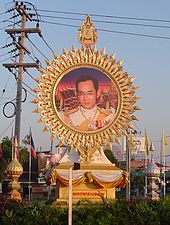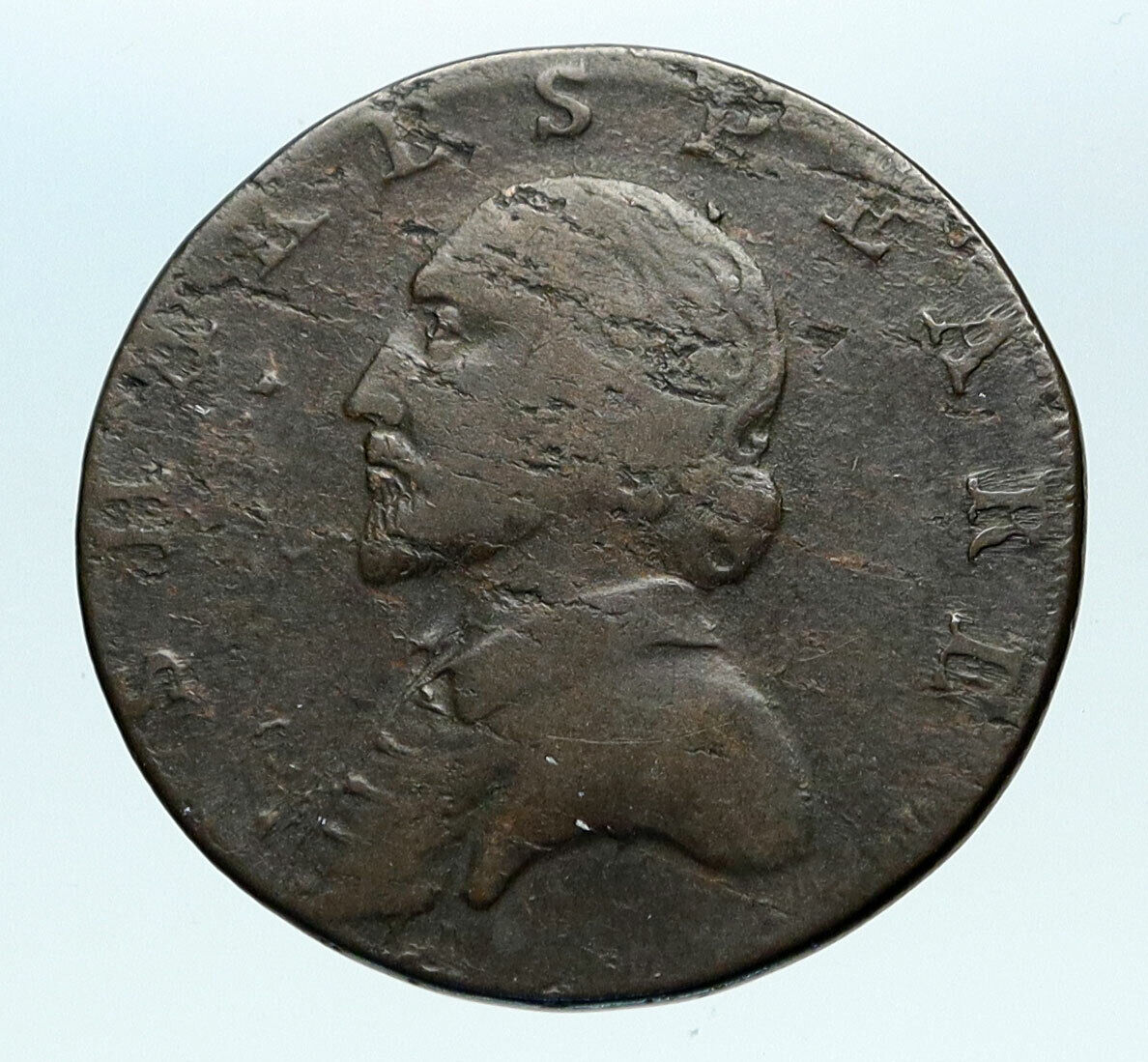|
Thailand under Rama IX – King: 9 June 1946 – 13 October 2016
Graduation of Princess Sirindhorn
1977 Nickel 10 Baht 32mm (15.02 grams)
Reference: Y# 115
เจ้าฟ้าสิรินธร ประเทศไทย, Princess Sirindhorn facing 3/4 left.
บัณฑิตพระองค์แรกในมหาวิทยาลัยประเทศไทย ๑๐ บาท พ.ศ.๒๕๒๐, Pyramid fountain with rays above.
You are bidding on the exact item pictured, provided with a Certificate of Authenticity and Lifetime Guarantee of Authenticity.

Bhumibol Adulyadej (Thai: ภูมิพลอดุลยเดช; RTGS: Phumiphon Adunyadet; pronounced; 5 December 1927 – 13 October 2016), conferred with the title King Bhumibol the Great in 1987, was the ninth monarch of Thailand from the Chakri dynasty as Rama IX. Reigning since 9 June 1946 he was, at the time of his death, the world’s longest-reigning head of state, the longest-reigning monarch in Thai history and the longest-reigning monarch having reigned only as an adult, reigning for 70 years, 126 days. During his reign, he was served by a total of 30 prime ministers beginning with Pridi Banomyong and ending with Prayut Chan-o-cha.
Forbes estimated Bhumibol’s fortune – including property and investments managed by the Crown Property Bureau, a unique body that is neither private nor government-owned (the assets managed by the Bureau are owned by the crown as an institution, not by the monarch as an individual) – to be US$30 billion in 2010, and he headed the magazine’s list of the “world’s richest royals” from 2008 to 2013. In May 2014, Bhumibol’s wealth was once again listed as US$30 billion.
After 2006, Bhumibol suffered declining health and spent extended periods at Siriraj Hospital, where he died on 13 October 2016. He was generally highly revered by the people in Thailand – many even saw him as close to divine. Notable political activists and Thai citizens who criticized the king or the institution of monarchy were often forced into exile or to suffer frequent imprisonments. Yet many cases were dropped before being proceeded or were eventually given royal pardon. His cremation was held on 26 October 2017 at the royal crematorium at Sanam Luang.
His successor, Vajiralongkorn, does not share his popularity, leading to concerns that the Thai monarchy will lose prestige and influence under the latter’s reign.
_(cropped).jpg/220px-ITU_Telecom_World_2016_–_VVIP_Tour_(30938750506)_(cropped).jpg) Princess Maha Chakri Sirindhorn, born April 2, 1955, formerly Princess Sirindhorn Debaratanasuda Kitivadhanadulsobhak (Thai: สมเด็จพระเจ้าลูกเธอ เจ้าฟ้าสิรินธรเทพรัตนสุดา กิติวัฒนาดุลโสภาคย์; RTGS: Sirinthontheppharattanasuda Kitiwatthanadunlasophak), is the second daughter of King Bhumibol Adulyadej and younger sister of King Vajiralongkorn. Princess Maha Chakri Sirindhorn, born April 2, 1955, formerly Princess Sirindhorn Debaratanasuda Kitivadhanadulsobhak (Thai: สมเด็จพระเจ้าลูกเธอ เจ้าฟ้าสิรินธรเทพรัตนสุดา กิติวัฒนาดุลโสภาคย์; RTGS: Sirinthontheppharattanasuda Kitiwatthanadunlasophak), is the second daughter of King Bhumibol Adulyadej and younger sister of King Vajiralongkorn.
Thais commonly refer to her as “Phra Thep” (Thai: พระเทพ), meaning “princess angel”. Her title in Thai is the female equivalent of the title once held by her brother, King Maha Vajiralongkorn. The Thai constitution was altered in 1974 to allow for female succession, thus making her eligible for the throne.
Having been the eldest female child of the royal family (excluding Princess Ubolratana Rajakanya, who married a foreign commoner), her position is comparable to a princess royal.
 Thailand, officially the Kingdom of Thailand, formerly known as Siam, is a country at the centre of the Indochinese peninsula in Mainland Southeast Asia. It is bordered to the north by Myanmar and Laos, to the east by Laos and Cambodia, to the south by the Gulf of Thailand and Malaysia, and to the west by the Andaman Sea and the southern extremity of Myanmar. Its maritime boundaries include Vietnam in the Gulf of Thailand to the southeast, and Indonesia and India on the Andaman Sea to the southwest. Thailand, officially the Kingdom of Thailand, formerly known as Siam, is a country at the centre of the Indochinese peninsula in Mainland Southeast Asia. It is bordered to the north by Myanmar and Laos, to the east by Laos and Cambodia, to the south by the Gulf of Thailand and Malaysia, and to the west by the Andaman Sea and the southern extremity of Myanmar. Its maritime boundaries include Vietnam in the Gulf of Thailand to the southeast, and Indonesia and India on the Andaman Sea to the southwest.
 Thailand is governed by the National Council for Peace and Order that took power in the May 2014 coup d’état. Its monarchy is headed by King Bhumibol Adulyadej, who has reigned since 1946 as Rama IX, as he is the ninth monarch of the Chakri Dynasty. He is currently the world’s longest-serving head of state and the country’s longest-reigning monarch; he has reigned for 69 years, 331 days. Thailand is governed by the National Council for Peace and Order that took power in the May 2014 coup d’état. Its monarchy is headed by King Bhumibol Adulyadej, who has reigned since 1946 as Rama IX, as he is the ninth monarch of the Chakri Dynasty. He is currently the world’s longest-serving head of state and the country’s longest-reigning monarch; he has reigned for 69 years, 331 days.
 With a total area of approximately 513,000 km2 (198,000 sq mi), Thailand is the world’s 51st-largest country. It is the 20th-most-populous country in the world, with around 66 million people. The capital and largest city is Bangkok, which is Thailand’s political, commercial, industrial, and cultural hub. About 75-95% of the population is ethnically Tai, which includes four major regional groups: central Thai, northeastern Thai (Khon [Lao] Isan), northern Thai (Khon Mueang); and southern Thai. Thai Chinese, those of significant Chinese heritage, are 14% of the population, while Thais with partial Chinese ancestry comprise up to 40% of the population. Thai Malays represent 3% of the population, with the remainder consisting of Mons, Khmers and various “hill tribes”. The country’s official language is Thai and the primary religion is Theravada Buddhism, which is practised by around 95% of the population. With a total area of approximately 513,000 km2 (198,000 sq mi), Thailand is the world’s 51st-largest country. It is the 20th-most-populous country in the world, with around 66 million people. The capital and largest city is Bangkok, which is Thailand’s political, commercial, industrial, and cultural hub. About 75-95% of the population is ethnically Tai, which includes four major regional groups: central Thai, northeastern Thai (Khon [Lao] Isan), northern Thai (Khon Mueang); and southern Thai. Thai Chinese, those of significant Chinese heritage, are 14% of the population, while Thais with partial Chinese ancestry comprise up to 40% of the population. Thai Malays represent 3% of the population, with the remainder consisting of Mons, Khmers and various “hill tribes”. The country’s official language is Thai and the primary religion is Theravada Buddhism, which is practised by around 95% of the population.
Thailand experienced rapid economic growth between 1985 and 1996, becoming a newly industrialised country and a major exporter. Manufacturing, agriculture, and tourism are leading sectors of the economy. Among the ten ASEAN countries, Thailand ranks third in quality of life. and the country’s HDI is rated as “high”. Its large population and growing economic influence have made it a middle power in the region and around the world.
|






_(cropped).jpg/220px-ITU_Telecom_World_2016_–_VVIP_Tour_(30938750506)_(cropped).jpg) Princess Maha Chakri Sirindhorn, born April 2, 1955, formerly Princess Sirindhorn Debaratanasuda Kitivadhanadulsobhak (Thai: สมเด็จพระเจ้าลูกเธอ เจ้าฟ้าสิรินธรเทพรัตนสุดา กิติวัฒนาดุลโสภาคย์; RTGS: Sirinthontheppharattanasuda Kitiwatthanadunlasophak), is the second daughter of King Bhumibol Adulyadej and younger sister of King Vajiralongkorn.
Princess Maha Chakri Sirindhorn, born April 2, 1955, formerly Princess Sirindhorn Debaratanasuda Kitivadhanadulsobhak (Thai: สมเด็จพระเจ้าลูกเธอ เจ้าฟ้าสิรินธรเทพรัตนสุดา กิติวัฒนาดุลโสภาคย์; RTGS: Sirinthontheppharattanasuda Kitiwatthanadunlasophak), is the second daughter of King Bhumibol Adulyadej and younger sister of King Vajiralongkorn. Thailand, officially the Kingdom of Thailand, formerly known as Siam, is a country at the centre of the Indochinese peninsula in Mainland Southeast Asia. It is bordered to the north by Myanmar and Laos, to the east by Laos and Cambodia, to the south by the Gulf of Thailand and Malaysia, and to the west by the Andaman Sea and the southern extremity of Myanmar. Its maritime boundaries include Vietnam in the Gulf of Thailand to the southeast, and Indonesia and India on the Andaman Sea to the southwest.
Thailand, officially the Kingdom of Thailand, formerly known as Siam, is a country at the centre of the Indochinese peninsula in Mainland Southeast Asia. It is bordered to the north by Myanmar and Laos, to the east by Laos and Cambodia, to the south by the Gulf of Thailand and Malaysia, and to the west by the Andaman Sea and the southern extremity of Myanmar. Its maritime boundaries include Vietnam in the Gulf of Thailand to the southeast, and Indonesia and India on the Andaman Sea to the southwest. Thailand is governed by the National Council for Peace and Order that took power in the May 2014 coup d’état. Its monarchy is headed by King Bhumibol Adulyadej, who has reigned since 1946 as Rama IX, as he is the ninth monarch of the Chakri Dynasty. He is currently the world’s longest-serving head of state and the country’s longest-reigning monarch; he has reigned for 69 years, 331 days.
Thailand is governed by the National Council for Peace and Order that took power in the May 2014 coup d’état. Its monarchy is headed by King Bhumibol Adulyadej, who has reigned since 1946 as Rama IX, as he is the ninth monarch of the Chakri Dynasty. He is currently the world’s longest-serving head of state and the country’s longest-reigning monarch; he has reigned for 69 years, 331 days. With a total area of approximately 513,000 km2 (198,000 sq mi), Thailand is the world’s 51st-largest country. It is the 20th-most-populous country in the world, with around 66 million people. The capital and largest city is Bangkok, which is Thailand’s political, commercial, industrial, and cultural hub. About 75-95% of the population is ethnically Tai, which includes four major regional groups: central Thai, northeastern Thai (Khon [Lao] Isan), northern Thai (Khon Mueang); and southern Thai. Thai Chinese, those of significant Chinese heritage, are 14% of the population, while Thais with partial Chinese ancestry comprise up to 40% of the population. Thai Malays represent 3% of the population, with the remainder consisting of Mons, Khmers and various “hill tribes”. The country’s official language is Thai and the primary religion is Theravada Buddhism, which is practised by around 95% of the population.
With a total area of approximately 513,000 km2 (198,000 sq mi), Thailand is the world’s 51st-largest country. It is the 20th-most-populous country in the world, with around 66 million people. The capital and largest city is Bangkok, which is Thailand’s political, commercial, industrial, and cultural hub. About 75-95% of the population is ethnically Tai, which includes four major regional groups: central Thai, northeastern Thai (Khon [Lao] Isan), northern Thai (Khon Mueang); and southern Thai. Thai Chinese, those of significant Chinese heritage, are 14% of the population, while Thais with partial Chinese ancestry comprise up to 40% of the population. Thai Malays represent 3% of the population, with the remainder consisting of Mons, Khmers and various “hill tribes”. The country’s official language is Thai and the primary religion is Theravada Buddhism, which is practised by around 95% of the population.




